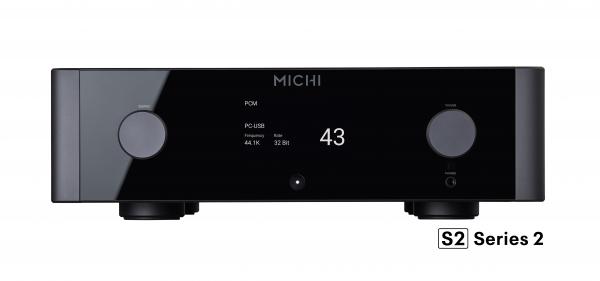Rotel Michi P5 S2

 After a period of uncertainty, Rotel’s destiny is firmly back in its own hands with new distribution partners in the EU, US and now the UK, courtesy of SME-owner Cadence
After a period of uncertainty, Rotel’s destiny is firmly back in its own hands with new distribution partners in the EU, US and now the UK, courtesy of SME-owner Cadence
The resurrection of Rotel’s Michi series, previously delighting audiophiles in the 1990s, was a hi-fi highlight of 2019. The Japanese manufacturer again created a strand of components (stereo and mono power amps, a preamp and two integrated models) with a focus on both high-end performance and aesthetics, even going so far as to drop the Rotel name from the branding. Then, in 2023, it announced it was revisiting three models in the lineup, making changes inside rather than out.
Successor to the P5 preamplifier, Rotel’s new Michi P5 S2 continues a trend seen in some of the company’s more affordable products and the Michi X3 S2 [HFN Jan ’24] and Michi X5 S2 integrateds – switching the DAC stage over from chips made by AKM to those from ESS. Partly borne out of necessity – a fire in the AKM factory in 2020 disrupted the supply chain – this means this second-generation unit is more of a ‘new’ model than it might look. And, yes, the price has gone up too, thanks to inflation and other factors: £4999 versus £3299 for the original P5 four years ago.
Chip Challenge
As Rotel explains it, a change of DAC chips isn’t simple as it combines the third-party hardware with power supply and output components of its own devising instead of implementing a complete off-the-shelf ‘module’. The P5 S2 therefore counts 129 component upgrades/changes, including the new pair of ESS’s eight-channel ES9028PRO DACs, running in dual-mono configuration. Volume and tone circuits, digital input switching/stabilisation and more have been re-worked and the DAC’s current mode output developed with ESS.
This new board, plus the P5 S2’s twin in-house-wound toroidal transformers and balanced Class A output stage, reside in a chassis measuring 485x150x452mm (whd). Beauty is in the eye of the beholder, and all that, but I would be surprised if anyone thought this Michi preamp didn’t look gorgeous, and perhaps even more ‘high-end’ than its price tag might suggest.
Rotel’s standard components are certainly not ugly, but their button-heavy fascias and – as on the RA-6000 amplifier – exposed heatsinks, warrant the term ‘industrial’. By contrast, the Michi series is all clean lines, curved edges and gloss-black style, and that includes the stereo and mono Class AB power amplifiers, which would make ideal aesthetic partners for the P5 S2. Opt for these and you shouldn’t have speaker-driving concerns either – the two-channel model, which is priced at £5399, achieved 2x670W/8ohm in our tests while the £6700 monoblock clocked up a handy 1.3kW/8ohm.
Sonic Switchboard
Back to the P5 S2, which is not networked but is still designed to be a complete system hub with a host of analogue and digital inputs. There are unbalanced RCAs for the unit’s MM/MC phono stage, plus CD, Tuner and Aux 1 and Aux 2 sources, as well as two sets of balanced XLR ins. There’s then a USB-B input, optical and coaxial inputs (both x3) and outputs, while analogue outputs are on balanced XLRs or single-ended RCAs, complemented by dual subwoofer pre-outs alongside a line output.
For system integration, the P5 S2 has a 12V trigger, RS232 and Ethernet sockets, plus a USB-A port provided for firmware updates and charging an external device. There’s also aptX HD Bluetooth onboard for mobile sources, plus a headphone amplifier feeding a 6.35mm front-panel socket.
That last connection is all that spoils the P5 S2’s minimalistic view, as all controls/settings, apart from the source and volume rotaries, are managed from its centralised display. This is not a touchscreen, but instead a supplied, slim remote control handset provides navigation and enter keys, in addition to volume, source, etc. Digging into the P5 S2’s settings is a doddle, as not only are the menus responsive to commands from the remote but they are intuitive too.
Options include MM/MC selection, input renaming and tone bypass, with a note in the manual warning that ‘a properly setup hi-fi system should not require changes to the Bass or Treble setting. Use these adjustments sparingly’. If, however, you decide to go against Rotel’s advice, the P5 S2’s display shows a clear ±10dB scale for its bass and treble control.
Rotel’s manual also says that ‘if you have experience with other stereo systems, you shouldn’t find anything perplexing’ about the P5 S2. It’s not fibbing, either. There’s very little housekeeping to do here, beyond dimming the display brightness if desired and being aware of its two PC USB-B settings – one supporting 24-bit PCM, DSD and MQA, the other solely for PCM to 32-bit.























































